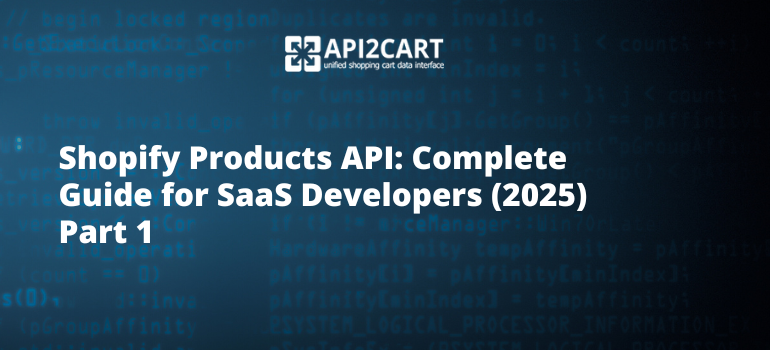
Shopify is one of the most popular eCommerce platforms, powering over 2.5 million live stores worldwide and operating in more than 175 countries. For software developers and SaaS providers, the ability to connect with Shopify is critical. In case your SaaS solution provides features such as product management, inventory syncing, multichannel selling, or order automation you will have to deal with Shopify Products API.
In this guide, we’ll cover what the Shopify Product API is, the specifics of working with Shopify products and how to easily implement Shopify integration and access needed data.
Shopify API: Get All Products from Shopify Stores
For SaaS providers building inventory management, analytics, or order-tracking tools, integration with Shopify get products API is one of the main business needs. Connection with Shopify API to get all products as well as manage product catalogs allows SaaS to provide valuable product management features for Shopify store owners.
Next, you’ll get insights into the Shopify Product API and how API2Cart helps SaaS connect with Shopify and 60+ other platforms through a single API, including methods for working with product data.
How to Add Products on Shopify API
Every month, Shopify merchants add millions of products to the platform. Automating this process is essential for them and SaaS tools such as PIM systems, ERP solutions, or multichannel platforms can deliver the features merchants need.
Developers who want to implement a feature of adding and updating products to Shopify stores via their apps or software have to deal with the Shopify API add product method. It’s commonly referred to as the Shopify product create API. With it you can bulk import products, assign attributes, and attach images.
By integrating with Shopify via API2Cart, SaaS or apps can easily add new products to the store using product.add method. The request structure looks like this:
{
"name": "Bag",
"model": "bag_01",
"description": "Product description",
"price": 99.9,
"status": "disabled",
"categories_ids": "23,56",
"is_virtual": false,
"available_for_view": true,
"available_for_sale": true,
"old_price": 99.9,
"special_price": 56.9,
"cost_price": 65.9,
"quantity": 0,
"manage_stock": false,
"warehouse_id": "1",
"backorder_status": "true",
"weight": 0,
"weight_unit": "lb",
"barcode": "9770317847001",
"harmonized_system_code": "123456",
"country_of_origin": "123456",
"manufacturer": "Samsung",
"search_keywords": "key1,key2,key3",
"tags": "tag1,tag2",
"meta_title": "category,test",
"meta_description": "category,test",
"seo_url": "some seo url",
"taxable": true
}
How to Update Product Information on Shopify
Industry research from Icecat shows that accurate and consistent product data can boost online store to 30% higher conversion rates. For software vendors, integration with Shopify API update product is a must-have for implementing the features for Shopify merchants like syncing prices, stock levels, or descriptions.
Connecting to Shopify update product API allows developers to adjust stock quantities automatically, update pricing rules in real time or synchronize product attributes such as size or color.
These features consistency across systems, improves customer experience, and eliminates manual errors in product data.
Using the product.update method provided by API2Cart software or apps can update certain product data such as description, price, quantity, package details, etc. Here is how the request structure looks like:
{
"id": "10",
"sku": "bag_01",
"name": "Pancil",
"description": "New product description",
"price": 99.9,
"old_price": 99.9,
"special_price": 56.9,
"cost_price": 65.9,
"taxable": false,
"status": "disabled",
"lang_id": "3",
"quantity": 6,
"manage_stock": false,
"backorder_status": "true",
"increase_quantity": 4,
"reduce_quantity": 4,
"warehouse_id": "1",
"weight": 23.69,
"is_virtual": false,
"barcode": "9770317847001",
"manufacturer": "Samsung",
"categories_ids": "23,56",
"meta_title": "category,test",
"meta_description": "category,test",
"seo_url": "some seo url",
"search_keywords": "key1,key2,key3",
"tags": "tag1,tag2",
"country_of_origin": "123456",
"harmonized_system_code": "123456"
}
How to Delete Products via Shopify API
Product catalogs are always evolving. Outdated or discontinued products can be removed programmatically with the integration with Shopify API delete product feature.
Using API2Cart product.delete method developers can securely delete products in bulk or individually. By having this functionality your eCommerce software will help merchants maintain catalog accuracy, automate data cleanup, and eliminate the risk of human error compared to manual deletion. Here is how the response structure looks like:
{
"return_code": 0,
"return_message": "string",
"result": {
"delete_items": 0
}
}
By integrating with the Shopify Products API, SaaS solutions gain direct access to product data and can build powerful features for their users:
- Real-time product synchronization;
- Automation of bulk operations;
- Data accuracy across systems;
- Automation of attribute updates;
- Automate repetitive catalog management tasks.
Unified Approach with API2Cart
While direct integration with Shopify API is powerful, maintaining it can be time-consuming. API2Cart offers a unified API that lets your software work not only with Shopify but also with 60+ other platforms (Magento, WooCommerce, PrestaShop, BigCommerce, and more).
API2Cart provides 100+ API methods to get, add, update and sync various store data such as products, customers, orders, shipments, etc.
Try API2Cart with a free 14-day trial and discover how easily you can manage products across Shopify and other platforms at once.
Read how to work with images, attributes, and categories in Part 2 of this guide.
FAQs
API2Cart offers a unified API that easily connect your software to Shopify and 60+ other popular eCommerce platforms and marketplaces, including Magento, WooCommerce, OpenCart, Wix, Etsy, Shopee, TikTok Shop, BigCommerce, and others, at once. With this service, you can update products on Shopify without developing a separate integration from scratch.



